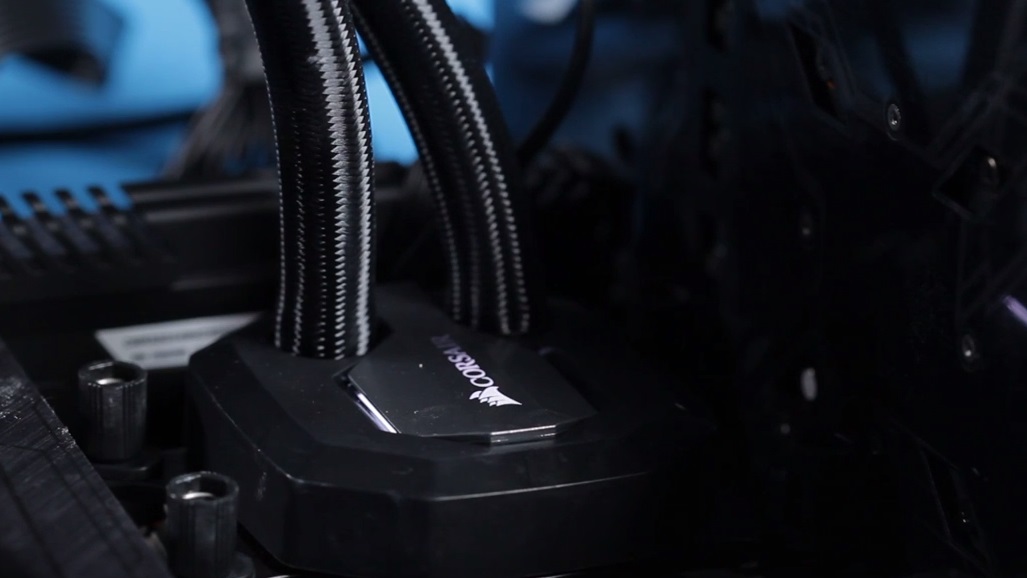The past few years have seen something of a plateau when it came to consumer processor technology, but this year both AMD and Intel have come out swinging with mighty 16-core behemoths.
AMD was first out of the gate with its Ryzen Threadripper 1950X, which features 16 cores, 32 threads, a base clock of 3.4GHz and a boost clock of 4.0GHz.
Almost everything about the Threadripper is over the top, and AMD knows it, from the physical size of the chip, the way it’s installed on a motherboard, the impressive-looking packaging and even its name.
It’s clearly a processor aimed at enthusiasts, and we’re impressed with AMD’s overall marketing and presentation of the Threadripper. It’s clearly excited and proud of the CPU, and that feeling is infectious.
Not to be outdone in the high core count stake, Intel then announced its line of Core i9 Skylake X processors, which included the 18-core Intel Core i9-7980XE and the 16-core Core i9-7960X. However, while AMD offers the Threadripper with a lot of bombast, Intel’s marketing of the Core i9-7960X is more restrained, so no dramatic-sounding names or fancy-looking packaging here.
However, the proof is in the performance and price of these CPUs, so, with both AMD and Intel releasing 16-core CPUs with 32 threads, we thought we’d pit them against each other to see which comes out on top.
AMD Ryzen Threadripper 1950X
For this test we tried to keep the two systems as similar as possible, with the processor and the motherboard being the biggest differences. For the AMD Threadripper 1950X machine, the components were:
Intel Core i9-7960X
Our test bench for the i9 processor is pretty similar to the Threadripper setup, with:

Round 1: Basic specifications
On paper the basic specifications hint at a pretty even match, with both the AMD Threadripper 1950X and Intel Core i9-7960X offering 16 cores and 32 threads. However, the AMD Threadripper 1950X wins out with a higher base clock than the Intel Core i9-7960X and more CPU memory cache. Threadripper also supports up to 64 PCI-E lanes, while the Core i9-7960X can handle 44 – still plenty, but not as many as AMD’s chip.
However, the Core i9-7960X bests the Threadripper when it comes to boost speeds, achieving 4.20GHz to the Threadripper’s 4.0GHz, and it also requires less power, with a TDP of 165W compared to the Threadripper’s 180W, which means PCs running the Core i9-7960X will run cooler, quieter and cheaper.
- Result: Tie

Round 2: 3D Mark Fire Strike benchmark
The first benchmark we ran was the 3D Mark Fire Strike, which tests how well machines can handle demanding 3D graphics. While there’s no doubt that at the moment 16-core processors are overkill for gaming, these benchmarks will give us an idea of the power differences between the two.
In this test the AMD Threadripper 1950X machine achieved a mighty score of 19,587, a big improvement over the 15,444 scored by the AMD Ryzen 7 1700 from our original AMD vs Intel showdown: what’s the best gaming CPU? head-to-head test.
However, the Intel Core i9-7960X performed even better, scoring a whopping 23,161, making it the clear winner in this test.
- Winner: Intel
Round 3: 3D Mark Fire Strike Ultra (4K) benchmark
In truth, both these processors (and the GTX 1080 Ti graphics card) are powerful enough to easily blow through the standard Fire Strike tests, but what about a more demanding benchmark? We also tried out the 3D Mark Fire Strike Ultra (4K) benchmark, which as the name suggests tests how well PCs can run ultra graphical settings in 4K resolutions.
As is to be expected, the scores for each CPU were lower than the standard test, with the AMD Threadripper 1950X machine scoring 7,007 and the Intel Core i9-7960X scoring 7,233.
- Winner: Intel

Round 4: 3D Mark Sky Diver benchmark
The Sky Diver benchmark isn’t as intensive as the Fire Strike tests, but it’s still a worthwhile tool for seeing just how well a PC can handle DirectX 11 graphics, especially when it comes to physics.
More realistic physics can mean more immersive games, so the higher the score here, the better.
First up was the AMD Threadripper 1950X machine, which scored a hefty 36,023 in the test. However, the Intel Core i9-7960X machine opened up a formidable lead with 59,785 – the biggest gap yet between the two CPUs. Can the Threadripper stage a comeback?
- Winner: Intel
Round 5: Geekbench 4
Switching to CPU benchmarks, the Geekbench 4 suite of tests puts the processor through its paces, replicating real-world tasks and applications, sometimes very complex ones, and uses those to see how the processors react. A higher score means the CPU is more proficient at completing those tasks.
In the single-core benchmark the Threadripper 1950X scored 3,672, while the Intel Core i9-7960X beat it with 4,919, which means that despite the higher clock speeds of the Threadripper the 7960X’s cores proved more powerful, helped by the higher boost speeds.
With Intel winning the single-core tests, we weren't too surprised to see that it also won the multi-core tests, with a score of 29,373 compared to AMD’s 13,935.
- Winner: Intel
Round 6: Cinebench benchmarks
Next up were the Cinebench benchmarks, which test the CPU and GPU capabilities of the machines, and while the CPU benchmark is the most telling result for this battle between AMD and Intel, the GPU test can show us which CPU can help the graphics card achieve higher frame rates.
The CPU test uses the PC’s processor to render a photorealistic 3D scene while running a number of algorithms designed to stress all available processor cores, so it’s a great way of seeing how good these processors are.
First up was the Threadripper machine, which scored 1,147, but the Core i9 machine blew past it with 3,149. The GPU test results were similarly stark, with AMD scoring 79.20 FPS while Intel achieved 138.68.
It’s another clear win for the Intel Core i9-7960X.
- Winner: Intel

Round 7: Total War: Warhammer 2
We also wanted to see how well these processors coped with modern games, even though many can’t yet take full advantage of 16-core CPUs. Total War: Warhammer 2 is a real-time strategy game which gives your processor a decent workout as it moves vast armies across the battlefield, and that makes it an excellent test for these chips.
At low settings, the AMD Threadripper 1950X beat the Intel Core i9-7960X, scoring 221.2 FPS to Intel’s 209.8 FPS. At Ultra settings, the Threadripper maintained its lead with a score of 94.3 FPS compared to Intel’s 91.7 FPS. When it comes to CPU-centric games, it looks like the Threadripper’s higher base clock helps it achieve slightly better results.
- Winner: AMD

Round 8: Middle Earth: Shadow of War
Next up we put the two machines through their paces with Middle Earth: Shadow of War. This recent open-world game is certainly a workout for your graphics card, but does the type of CPU you use have an effect as well?
It appears so, with the Intel Core i9-7960X machine achieving 127 FPS on Ultra settings and 178 FPS on Low settings – a big lead over the AMD Threadripper 1950X, which scored (a still very good) 95 FPS on Ultra and 115 FPS on Low.
- Winner: Intel
Round 9: Price
Our final round is perhaps the most important one, as it puts the performance differences between the two chips into context. AMD has traditionally offered processors (and graphics cards) that are lower-priced than its competitors', and with the AMD Threadripper 1950X we’re pleased to see that this has continued. That’s not to say the Threadripper is cheap – at $999 / £999 / AU$1,440 it’s certainly a big investment.
However, the Intel Core i9-7960X is a fair bit more expensive at $1,699 / £1,700 (around AU$2,150). That's 70% more, but while our tests show the Intel CPU has a performance advantage over the AMD Threadripper, it’s around the 50% mark – and we should reiterate that the Intel doesn’t outperform the Threadripper consistently.
- Winner: AMD
Conclusion
So, is an at-best 50% performance increase worth a 70% price premium? We’d say not, actually, as the Threadripper is still an awesome-performing CPU, more than capable of handling modern tasks. If you’re a gamer, many games won’t even take advantage of the Threadripper1950X’s power, let alone the Intel Core i9-7960X’s, so at the moment you may be paying more for performance you won’t benefit from.
However, if you do a lot of content creation, or work with a lot of resource-hungry applications where multitasking is essential, the Intel Core i9-7960X's performance advantage in some areas will be well worth the money.
We’ve been incredibly impressed with both CPUs, and they show what a bit of healthy competition can do to the processor market. While the Intel Core i9-7960X takes the performance crown, the AMD Threadripper 1950X is no slouch either, and its lower price makes it an incredibly tempting purchase. For those reasons we’re calling this battle the two 16-core behemoths a tie.
- Overall result: Tie
from TechRadar - All the latest technology news http://www.techradar.com/news/amd-vs-intel-the-16-core-showdown
No comments:
Post a Comment